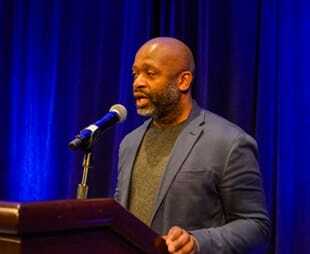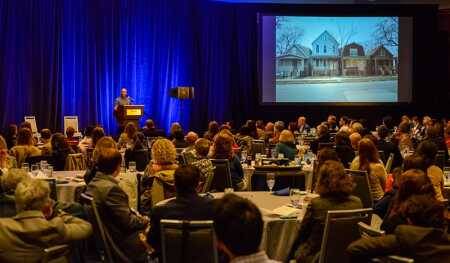The conventional relationship between a real estate developer and an artist might go like this: the former commissions the latter to create art for a specific space—a mural or sculpture for a lobby, courtyard, or community room—with an intention to enhance an asset’s value, contribute to placemaking, or build a sense of pride among occupants about where they live.
Chicago-based Theaster Gates, on the other hand, may be the only artist in the United States who is merging the roles of artist and real estate developer. A celebrated and commercially successful multimedia artist who has exhibited work in museums and galleries around the world, Gates has transformed blocks of his South Side neighborhood through key investments in housing and unique community assets that provide residents with outlets for expression while preserving local culture before it disappears.
Related: Revitalizing the Soul and the Neighborhood through Art
In a keynote presentation at the recent ULI Housing Conference in Boston, Gates told the story of how he turned his attention to the South Side, once home to public housing high rises that concentrated poverty, bred violence, and have since been demolished. The neighborhood, far from the prosperity of downtown, still suffers from a widespread lack of private investment. Looking beyond the walls of his artist studio to the distressed properties down the street, Gates has embraced the role of the artist as an agent of change.
“There is a way in which I can no longer imagine that everyday activity is separate from my artistic activity,” he said. “If that’s the case, then the everyday activity in my neighborhood should be as beautiful as things that happen in a museum setting…. I want us all to imagine a more pleasurable journey in housing.”
In 2010, Gates established the Rebuild Foundation, which purchased several vacant and blighted properties and turned them into one-of-a-kind, community-minded projects. Built-in partnership with the Chicago Public Housing Authority, Brinshore Development, and Landon Bone Baker Architects, the Dorchester Art + Housing Collaborative renovated the Dante Harper Townhomes—a former public housing site—into a 32-unit, mixed-income, rental housing community that includes 12 units of public housing, 11 units of affordable rentals, and nine market-rate units and studio spaces for artists. The project also features an arts center with a full calendar of programming, a dance studio, a public meeting space, and a community garden.
Culture, according to Gates, can be a great equalizer among people with a variety of backgrounds and incomes by shifting the focus away from economic differences. “Instead of talking so much about economic integration, let’s talk about the shared values of culture,” he said.
Culture also allows the development community to aim higher than simply building more units: “Can we imagine that culture might be a partner, so that the thing we build becomes the most beautiful thing not just the most occupyable thing?”
Several vacant commercial structures also have seen new life under Gates’s vision. He purchased an old bank building from the city of Chicago for $1 and turned it into the Stony Island Arts Bank, a library and archive for African American culture, including back issues of Jet and Ebony magazines, the vinyl collection of a long-closed South Side record store, and art history materials from the University of Chicago. The Archive House is a rehabilitated structure that houses cultural material from shuttered South Side businesses. And the Black Cinema House screens movies by and about members of the African diaspora and offers video storytelling classes to neighborhood youth in a refurbished Anheuser-Busch distribution facility, an example of one of the many underused, formerly industrial sites scattered throughout the South Side.
All told, Gates’s work has resulted in $45 million in investment in the South Side, with 65 new units of affordable housing and state-of-the-art community spaces. He is unsure about the long-term sustainability of ground-breaking programs and cultural infrastructure he has created, but expressed optimism about future partnerships. Private developers are now a bit more curious about a neighborhood they previously dismissed, he said.
Although he seeks to break down silos and defies easy categorization himself, Gates is clear about one thing: he has no interest in becoming a full-time developer. While pursuing a fellowship at Harvard University’s Graduate School of Design, he realized that he “didn’t have the skills to be a full-time developer, but I did have the ability to add value in communities so another kind of layer on top of the development work … could happen.”
His development partners, in turn, have relied on his fine-tuned knowledge of the community and cultural instincts to create spaces that are unlike anyplace else in Chicago. As he so eloquently put it to them, “You aggregate the stack, and I’ll think about beauty.”
Archana Pyati is a writer on the ULI Strategic Communications team.






